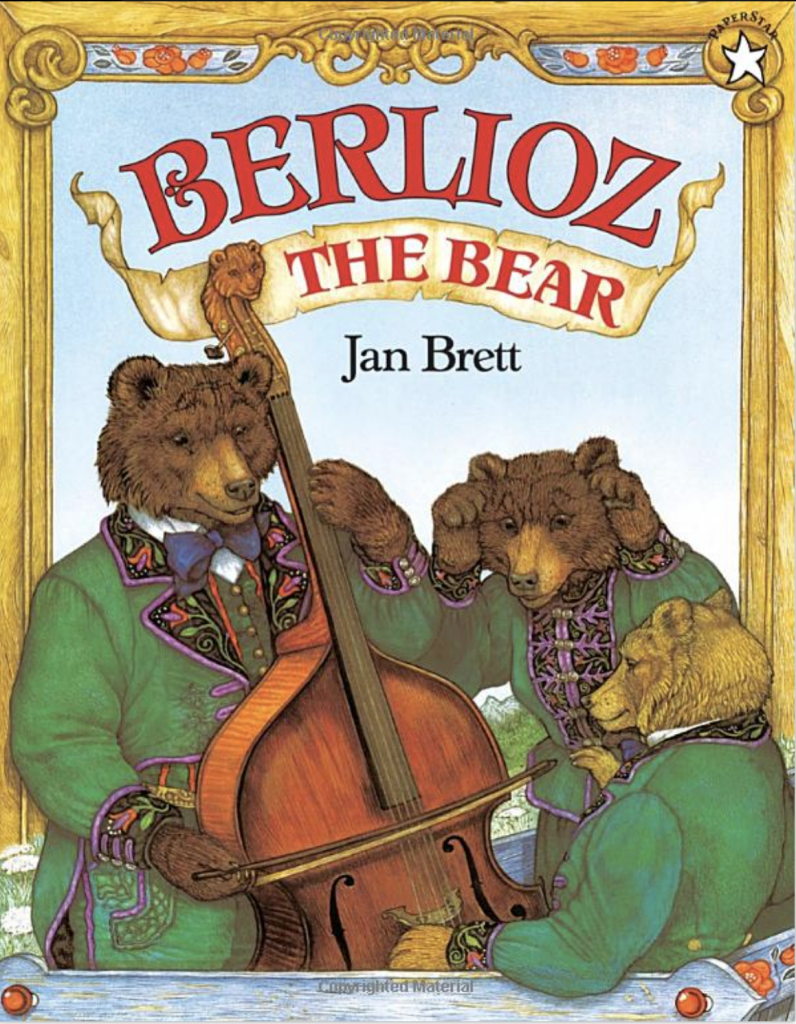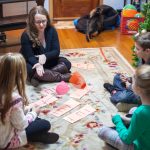May 1
Week 1
This week you’ll learn the nursery rhyme Bee Bee Bumble Bee and practice saying it with your child. Start with three to four repetitions with each session. Click the title below, and you’ll also start the routine of listening to our monthly playlist. Try every morning while getting ready, or every evening during dinner, or the bedtime routine. Click the Words and Activities titles for pdfs to the lyrics and a printable bee chart.
You can cast this to your smart speaker at home, or add to your own YouTube music app to listen to in the car or whenever it’s convenient for you. Try to listen to it every day for the month of May.
Bee Bee Bumble Bee
Bee Bee Bumble Bee
Stung a man upon his knee
Stung a pig upon his snout
I declare that you are out
Bzzz Bzzz Bzzz Bzzz
Tapping a picture: Using a picture of a bee, tap and say the words to show steady beat.
Patting your body or your child’s: Pretend the bee is trying to sting different body parts and pat that.
Fast/Slow: Practice saying fast (rabbit) and slow (turtle).
Loud/Soft: Practice using loud (lion) and soft (mouse) voices.
High/Low: Practice using a high (butterfly) or low (frog) voice. Use puppets or pictures of these animals to demonstrate reinforce the animal.
Large Family/Small Homeschool Group
Small Group Game: make a circle with fists in the center. Say the rhyme while tapping fists and the last person to be tapped on the last Bzzz is “out” and has to sit and tap their legs while pretending the bee is trying to sting their legs or tap a drum.
Week 2
This week you’ll learn the song Rain, Rain Go Away. You may already know it. It’s perfect to sing on rainy days, but also days when you pretend it’s raining. We like to turn off the lights when singing to pretend it’s a stormy day outside. Start with three to four repetitions with each session. Continue to listen to the classical music playlist. This week we’ve added a little more information related to the piece.
J.S. Bach was a German composer and musician during the Baroque era. He wrote pieces for solo and ensembles with organ, choir, harpsichord (the ancestor to the piano), strings, and full orchestras. A few of his famous pieces are St. Matthew’s Passion, Mass in B Minor, Brandonburg Concertos, The Well-Tempered Clavier, Air on a G String, Cello Suite No. 1, and more.
J.S. Bach stands for Johann Sebastian Bach. He had 7 children with his first wife, Maria, and 13 children with his second wife, Anna. His children Wilhelm Friedemann and Carl Philipp Emanuel aka C.P.E. Bach became musicians and composers too.

Rain, Rain Go Away
Rain, rain go away
Come again some other day
Little Susy wants to play
Stormy Afternoon: Turn out the lights and pretend it’s a stormy day and we can’t go play outside. Add a flashlight to the mix to create a lightening feel.
Instruments: Try to play with rhythm sticks. Don’t have any? Just use wooden spoons or pencils. You’ll practice the steady beat with these. Add a rain stick. Check out this video for a craft to make your own rainstick. Too involved? Try just filling an old jar with beans and rice. Decorate how you like. You can also just purchase one from Amazon for years of fun.
Steady Beat: Tap this umbrella chart while singing to the steady beat. This will reinforce beat and prepare the left to right progression, which is an early reading skill. Click the steady beat heading for a print out for this.
Improvisation: Substitute your child’s name for Susy. You can also have your child choose names like mommy, daddy, siblings, pets, friends, family, etc.
High/Low: Reinforce high and low sounds, by pretending to open an umbrella and closing the umbrella to the beat.
Week 3
This week you’ll learn the rhyme Climb Up The Ladder. Start with three to four repetitions with each session. Shoot for every morning, evening, or mealtime. Continue to listen to the classical music playlist. Can you incorporate movement with ribbons this week? Twirling, gliding, spinning?
Climb up the ladder
Hurry to the slide
Sit at the top and
down you slide
Sensory: Walk fingers up one arm. Stop at the top of the head, and slide fingers down other arm. Variation: starting on legs, belly, back.
Locations: Try saying this outside on a playground, in your back yard by the slide, on the way to the slide, inside talking about going to a playground, etc.
Crafts: Try building your own slide using this origami craft or popsicle stick craft. (The popsicle stick craft is more involved, but great for older siblings and crafty parents.) After you build it, take a toy down the slide while saying the rhyme.
Improvisation: Substitute slide for other playground activities. “Climb up the ladder, hurry to the pole, grab the pole and down you slide.” “Climb up the ladder, hurry to the swing, sit on the seat, and away your swing.”
Imagination: Tell a creative story about a friend climbing up the ladder. Say it inside with a toy. “Rapunzel is trapped in the tower, but her friend says this rhyme and helps her slide out the window to safety.”
Week 4
This is your review week, also known as your catch up week. While you may be thankful for the reprieve, it’s not actually designed for your benefit. Each musical session you create should have 3-4 repetitions. Then you’ll do each rhyme/song 3-4 sessions a week, and now you’ll review all the pieces you taught for the week. This creates a musical atmosphere where both you and the child(ren) have really learned the songs and rhymes. Then these three songs and rhymes can be reviewed whenever a bee appears, it’s raining, or you want to go to the playground. The crafts, activities, and books are fun interesting ways to extend, expand, and internalize the material. If all you can do is say the rhyme 3 times a day everyday, you are successful!
We’re listening to the same piece for the entire month. Just put it on in the background. The more you listen to it the more you’ll hear interesting things in it and the more you’ll grow to love it. This can feel heavy the first few times you listen, but eventually you’ll notice little nuances in it and really appreciate it. The simplest is to turn it on the morning while everyone is getting ready for the day. Get dressed, eat breakfast, etc, while it’s on in the background. If you want to add an activity to it, try a free coloring/painting activity or movement with scarves. Choose a word like slide, spin, roll, twirl, and see how you can make your body movements reflect that word.
Bee Bee Bumble Bee
Stung a man upon his knee
Stung a pig upon his snout
I declare that you are out
Bzzz Bzzz Bzzz Bzzz
Crafts: Create a cute bee puppet using this very easy bee craft. Then practice saying the rhyme while flying the bee around the room.
Sing the song while reading this book from the library or amazon, and discover how the bee saves the day. Listen to Flight of the Bumblebee by Rimsky-Korsakov or watch this Flight of the Bumblebee video.
Rain, rain go away
Come again some other day
Little Susy wants to play
Sing the song while reading this book from the library or amazon.

Climb up the ladder
Hurry to the slide
Sit at the top and
down you slide
The best part of this activity is the guardian/child interaction. The cuddles, the wiggles, the tickles. They love being held and touched by you and will ask for more and more over and over. Teach this to another parent, guardian, grandparent, etc. Enjoy extending this to the whole family.
Now you’re trying to review all three pieces three times a day every day. It feels like a lot, but remember, you already know them now, and your children will too. See how the nonverbal ones’ faces light up when they recognize these songs and rhymes. See how the verbal kids join in singing.
When do I do these?: In the morning, at breakfast, while getting ready, at lunch, in the car, at the library, outside playing.
Extensions: Just try to sing the song and rhymes 3-4 times each day. When you have a day off, investigate your favorite book and/or craft. If it’ll take a few days to get the book, that’s okay. We want to review these songs after this class is over.








